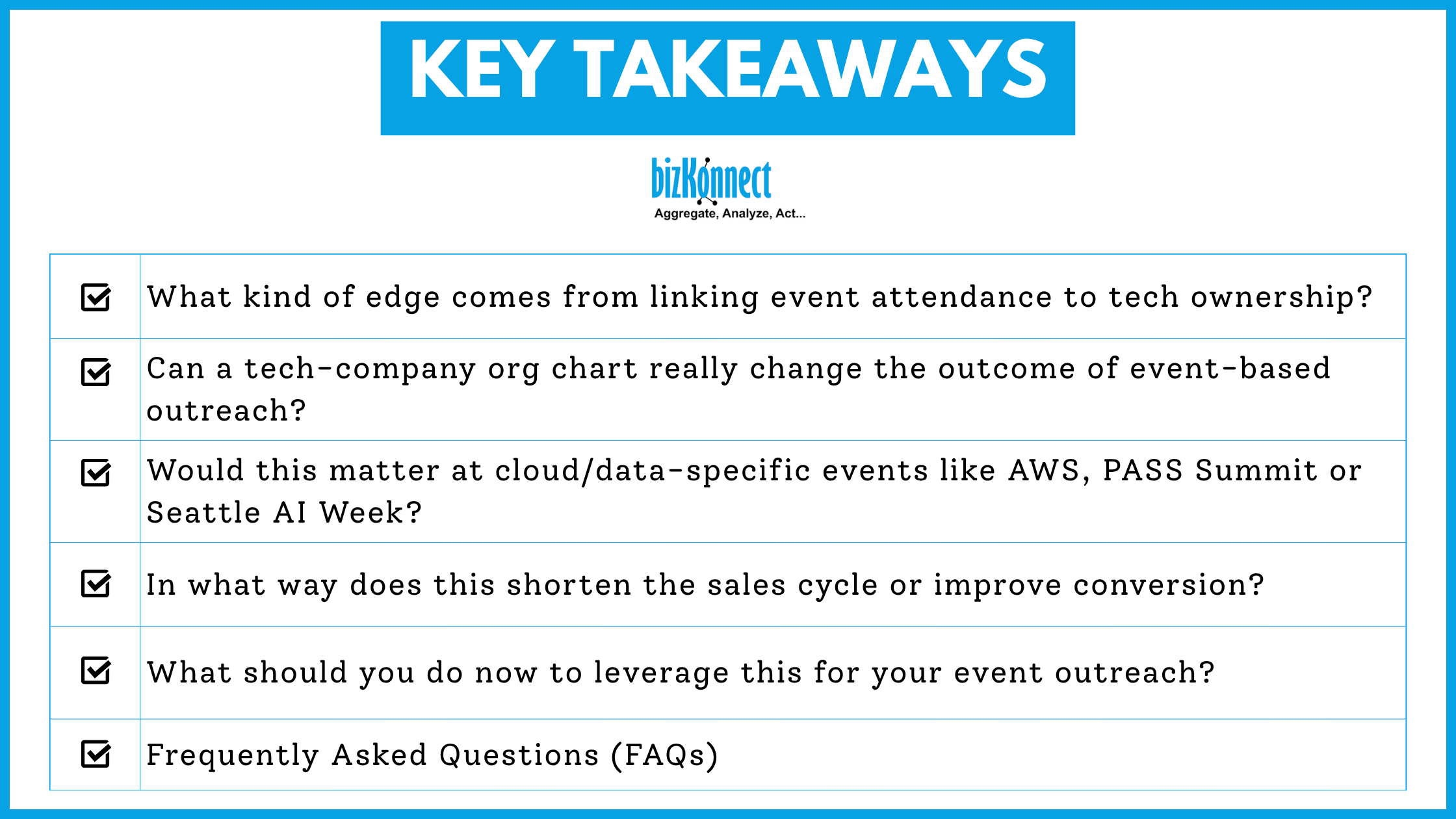Turning attendance at major cloud and data events into deal acceleration often comes down to one core move: adding context to the contacts you capture. And, pairing that intelligence with localized human connection.
When your local U.S. executives or regional representatives attend events like PASS Summit, Seattle AI Week, or AWS re:Invent, they don’t just network; they personalize presence. Their on-ground interactions backed by GenAI-driven tech company org charts form a hybrid engagement model that connects face-to-face credibility with digital precision.

Thus, you walk into the event (or follow up post-event) with more than just names. You carry reports, hierarchies, business units, decision-makers, and insights: all mapped to the people your regional teams just met. You aren’t reaching out blindly, rather you are reinforcing a local conversation with a globally coordinated campaign. In the end, you are building the pipeline faster because you know which players matter and who your messages should reach first.
What kind of edge comes from linking event attendance to tech ownership?
When you show up at a cloud/data event, you’re among hundreds or thousands of attendees. But only a fraction of them control the budgets or own the technology decisions you care about. For instance:
- According to recent data, 81% of trade-show attendees have buying authority.
- Yet about 80% of leads from trade shows never get followed up.
That’s why when your ABM strategy integrates this intelligence like knowing which companies were there, which tech stacks they own, and who within their org holds influence, you can zero in on high-value prospects.
A regional executive’s quick introduction on-site can then be reinforced through theme-based post-event campaigns. That alignment between human touch and structured data makes each follow-up more contextual and persuasive.
Can a tech-company org chart really change the outcome of event-based outreach?
Yes. Let’s compare two scenarios:
Blind outreach after an event:
You upload an attendee list, craft a generic email: “We saw you at PASS Summit, let’s talk cloud/data.” Many recipients shrug, response rate is low, and momentum fades.
Org-chart-driven, ABM-aligned outreach:
You map the list against a structured org chart of your target company: business unit X, role “Director of Data Platform,” reports to “VP Engineering,” project “migrating from AWS to hybrid.”
Alongside this, you enrich that map with people-attending data who from each company was actually present, what sessions they joined, and which topics drew their attention. That insight adds behavioral context to your structural intelligence. You now know not only who they are in the hierarchy, but also what they showed interest in.
Your local rep follows up with a personalized note, and your marketing team triggers a theme-based campaign referencing the same initiative:
“Noticed your team just announced a shift from AWS Redshift to managed lake-house. We’ve helped similar firms reduce query costs by 30 %. Might be worth a quick call.”
The context is complete: a face-to-face introduction supported by tailored messaging. This hybrid approach shortens the engagement cycle and converts warm event leads into qualified opportunities.
Statistically, companies that combine contextual data and timely follow-up outperform those relying solely on post-event lead dumps. For instance:
- For those who put in the effort and follow up, 5 to 10% of trade show leads can convert.
- On average, a trade show lead can cost $811.
That’s why the best-performing ABM teams now merge event presence with personalized, theme-based follow-up campaigns built on accurate org data.
Would this matter at cloud/data-specific events like AWS, PASS Summit or Seattle AI Week?
Absolutely. These events attract attendees with genuine intent such as upcoming migrations, data modernization, AI pilots. Having pre-mapped org charts and local representation means:
- You identify which companies are attending.
- You map those companies to relevant tech units.
- Your local U.S. representatives engage key attendees in person.
- Your ABM team launches theme-based follow-ups referencing the same discussions or sessions.
Because event momentum decays quickly, this digital-plus-local approach keeps the conversation alive while competitors are still sorting spreadsheets.

In what way does this shorten the sales cycle or improve conversion?
Here are key advantages of this hybrid ABM model:
- Higher relevance: Local introductions connect instantly, while campaign follow-ups sustain attention.
- Faster dialogue: Knowing who owns the tech shortens the path to the decision maker.
- Cross-channel consistency: Every email, meeting, and outreach aligns with one narrative.
- Pipeline creation, not just lead capture: You convert presence into opportunity, not just visibility.
What should you do now to leverage this for your event outreach?
- Align your ABM team, local executives, and marketing operations before major events.
- Map attendee lists to tech-company org charts.
- Identify decision makers and their business units.
- Plan a theme-based campaign with one narrative connecting event sessions, local discussions, and product relevance.
- Follow up within 48 hours using both the local representative and ABM email touchpoints.
Event attendance alone is only the first step. Real acceleration happens when you connect that presence with GenAI-driven org insights, ABM precision, local representation, and theme-based campaign orchestration. This hybrid model of a local rep backed by intelligent data, turns participation into a qualified pipeline, ensuring every handshake, email, and follow-up works in harmony.
Frequently Asked Questions (FAQs)
Q1. How do local U.S. executives influence event-driven deal acceleration?
They add credibility and context on-site. Combined with ABM and org charts, their follow-up is precise and relevant, boosting engagement and conversion.
Q2. Why combine ABM with event marketing?
ABM focuses on the right accounts, not every attendee. It ensures campaigns are targeted, personalized, and aligned with key decision makers.
Q3. How soon should post-event outreach begin?
Within 24-48 hours, while attendees are still engaged. Local reps plus ABM campaigns ensure quick, high-impact follow-ups.
Q4. Can this hybrid model work for smaller events?
Yes. The combination of local presence, ABM, and org-chart data works even in niche or regional events, often with higher visibility.
Stop guessing the org structure. See how BizKonnect reveals decision chains using GenAI. FREE SAMPLE.